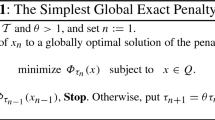Abstract
In this paper a new continuously differentiable exact penalty function is introduced for the solution of nonlinear programming problems with compact feasible set. A distinguishing feature of the penalty function is that it is defined on a suitable bounded open set containing the feasible region and that it goes to infinity on the boundary of this set. This allows the construction of an implementable unconstrained minimization algorithm, whose global convergence towards Kuhn-Tucker points of the constrained problem can be established.
Similar content being viewed by others
References
D.P. Bertsekas,Constrained Optimization and Lagrange Multiplier Methods (Academic Press, New York, 1982).
A.R. Conn, “Penalty function methods”, in: M.J.D. Powell, ed.,Nonlinear Optimization 1981 (Academic Press, New York, 1982) pp. 235–242.
G. Di Pillo and L. Grippo, “A class of continuously differentiable exact penalty function algorithms for nonlinear programming problems,” in: P. Toft-Christensen, ed.,System Modelling and Optimization (Springer-Verlag, Berlin, 1984) pp. 246–256.
G. Di Pillo and L. Grippo, “An exact penalty method with global convergence properties for nonlinear programming problems”, Technical Report R.99, IASI-CNR (Roma, October 1984).
G. Di Pillo and L. Grippo, “A continuously differentiable exact penalty function for nonlinear programming problems with inequality constraints”,SIAM Journal on Control and Optimization 23 (1985) 72–84.
G. Di Pillo, L. Grippo and S. Lucidi, “Globally convergent exact penalty algorithms for constrained optimization”, Contributed paper, 12th IFIP Conference on System Modelling and Optimization, Budapest, September 1985.
J.P. Evans, F.J. Gould and J.W. Tolle, “Exact penalty functions in nonlinear programming”,Mathematical Programming 4 (1973) 72–97.
A.V. Fiacco and G.P. McCormick,Nonlinear Programming: Sequential Unconstrained Minimization Techniques (Wiley, New York, 1968).
R. Fletcher, “A class of methods for nonlinear programming with termination and convergence properties”, in: J. Abadie, ed.,Integer and Nonlinear Programming (North-Holland, Amsterdam, 1970) pp. 157–173.
R. Fletcher, “Penalty functions”, in: A. Bachem, M. Grötschel and B. Korte, eds.,Mathematical Programming. The State of the Art (Springer-Verlag, Berlin, 1983) pp. 87–114.
T. Glad and E. Polak, “A multiplier method with automatic limitation of penalty growth”,Mathematical Programming 17 (1979) 140–155.
S.P. Han and O.L. Mangasarian, “Exact penalty functions in nonlinear programming”,Mathematical Programming 17 (1979) 251–269.
O. L. Mangasarian,Nonlinear Programming (Prentice-Hall, Englewood Cliffs, NJ, 1969).
D.Q. Mayne and N. Maratos, “A first order, exact penalty function algorithm for equality constrained optimization problems”,Mathematical Programming 16 (1979) 303–324.
D.Q. Mayne and E. Polak, “A superlinearly convergent algorithm for constrained optimization problems”,Mathematical Programming Study 16 (1982) 45–61.
N. Mukai and E. Polak, “A quadratically convergent primal-dual algorithm with global convergence properties for solving optimization problems with equality constraints”,Mathematical Programming 9 (1975) 336–349.
T. Pietrzykowski, “An exact potential method for constrained maxima”,SIAM Journal on Numerical Analysis 6 (1969) 294–304.
E. Polak, “On the global stabilization of locally convergent algorithms”,Automatica 12 (1976) 337–342.
J.E. Spingarn and R.T. Rockafellar, “The generic nature of optimality conditions in nonlinear programming”,Mathematics of Operations Research 4 (1979) 425–430.
W.I. Zangwill, “Nonlinear programming via penalty functions”,Management Science 13 (1967) 344–358.
Author information
Authors and Affiliations
Rights and permissions
About this article
Cite this article
Di Pillo, G., Grippo, L. An exact penalty function method with global convergence properties for nonlinear programming problems. Mathematical Programming 36, 1–18 (1986). https://doi.org/10.1007/BF02591986
Received:
Revised:
Issue Date:
DOI: https://doi.org/10.1007/BF02591986



